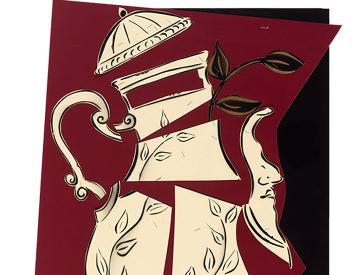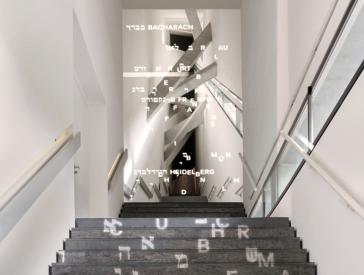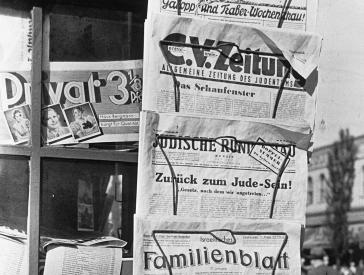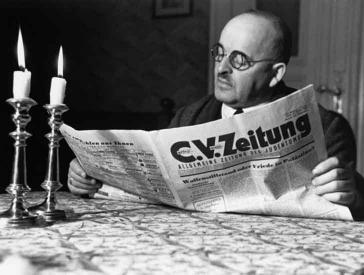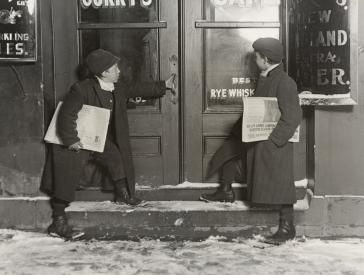»Bedřich Fritta. Zeichnungen aus dem Ghetto Theresienstadt«
Presseinformation
Pressemitteilung von Mi, 15. Mai 2013
Mit einer ersten umfassenden Schau widmet sich das Jüdische Museum Berlin dem tschechischen Grafiker und Karikaturisten Bedřich Fritta (1906 – 1944). Zwischen 1942 und 1944 hielt er heimlich in mehr als hundert Grafiken den Ghettoalltag in Theresienstadt fest. Nach der Aufdeckung wurde er wegen sogenannter „Gräuelpropaganda“ im Oktober 1944 nach Auschwitz deportiert, wo er wenig später umkam. Etwa einhundert großformatige Tuschezeichnungen und Skizzen blieben in einem Versteck erhalten. Sie sind heute im Besitz seines Sohnes Thomas Fritta-Haas.
- Kontakt
-
Pressestelle
T +49 (0)30 259 93 419
presse@jmberlin.de - Postadresse
Stiftung Jüdisches Museum Berlin
Lindenstraße 9–14
10969 Berlin
Aus Anlass des Themenjahrs „Zerstörte Vielfalt“ präsentiert das Jüdische Museum Berlin 38 großformatige Tuschezeichnungen und zahlreiche Skizzen.
Bedřich Frittas Arbeiten wurden bislang vor allem als zeithistorische Quelle verstanden. Diese Ausstellung hingegen legt den Fokus auf die künstlerischen Mittel, mit denen Fritta den Ghettoalltag deutete. Dabei werden die Vielfalt seiner Bildsprache und die außergewöhnliche künstlerische Qualität der Blätter deutlich.
Zwischen Auftrag und Widerstand
Fritta wurde 1941 im Alter von 35 Jahren zusammen mit seiner Frau Johanna und seinem kaum einjährigen Sohn Tomáš nach Theresienstadt deportiert. Im Ghetto leitete der Prager Grafiker und Karikaturist das amtliche Zeichenstudio der jüdischen Selbstverwaltung. Im Auftrag der SS mussten bis zu 20 Künstler Baupläne und Propagandamaterial herstellen. Dort gab es Tusche und Papier, mit denen die „Theresienstädter Maler“ heimlich und unter Lebensgefahr das Elend des realen Ghettoalltags festhalten konnten. Viele dieser künstlerischen Arbeiten blieben in sicheren Verstecken erhalten – Frittas Zeichnungen wurden kurz vor seiner Verhaftung in einer Blechdose auf einem Bauernhof vergraben.
Neue Sicht auf Frittas Werke
Als ausgebildeter Zeichner, Werbegrafiker und Karikaturist beherrschte Fritta souverän die Stilmittel seiner Zeit. Die im offiziellen Auftrag entstandenen Zeichnungen zeigen den Aufbau der Infrastruktur des Ghettos, den Alltag beschönigend, ohne das Elend erahnen zu lassen. In den illegal angefertigten Zeichnungen setzt Fritta unterschiedliche künstlerische Mittel ein, um die ihn umgebende Realität zu deuten.
Die Ausstellung (17. Mai bis 29. September 2013) zeigt die gesamte Bandbreite seiner künstlerischen Ausdrucksmittel. In der Gruppe von Zeichnungen, die in der Ausstellung unter der Überschrift „Phantasmagorien“ zusammengefasst sind, knüpft Fritta an die Bildsprache des Phantastischen und Grotesken an, was an die schaurigen Bildwelten Alfred Kubins erinnert.
Von expressionistischer Intensität sind die Tuschezeichnungen mit ihren scharfen Kontrasten. Helle Schlaglichter treffen auf die düstere Realität der Sammelunterkünfte, Innenhöfe, Werkstätten und Straßen des Ghettos. Fritta arbeitet mit den Effekten der künstlichen Beleuchtung, wie sie aus dem Film bekannt waren.
Frittas frühere Tätigkeit als Karikaturist wird deutlich in seinen Federzeichnungen mit ihren dünnen, klaren Linien. Sie erinnern an die Formensprache der sozialkritischen Expressionisten, etwa an George Grosz oder Otto Dix. Er setzt sie ein, um scharfe Kritik am privilegierten Leben der Inhaftierten mit Prominentenstatus zu üben. So karikiert Fritta auch die groß angelegte „Verschönerungsaktion“, mit der die SS die internationale Öffentlichkeit über die realen Verhältnisse im Ghetto täuschte. Die „Mustersiedlung“ mit Cafés und Läden wird zur Farce aus mühsam gestützten Fassaden vor Leichenbergen.
Ein Bilderbuch für Sohn Tommy
Tomáš, genannt Tommy, bekam zu seinem dritten Geburtstag im Ghetto von seinem Vater Bedřich ein Bilderbuch. In farbigen Darstellungen zeichnet Fritta den Alltag seines Sohnes in Theresienstadt nach. Ein Großteil der Zeichnungen führt auch in eine imaginäre Welt: Phantasien von gemeinsamen Reisen des Vaters mit dem Sohn durch fremde exotische Länder oder die Darstellung verschiedener Berufswünsche. So sollte sich sein kleiner Sohn eine Welt auch außerhalb des Ghettos vorstellen können. Das Bilderbuch erhielt Tomáš später von seinem Adoptivvater Leo Haas, der als Einziger der „Theresienstädter Maler“ nach ihrer Entdeckung überlebte und später Frittas Bilder und das Kinderbuch aus dem Versteck holte.
Als besondere Leihgabe für die Ausstellung kann das Jüdische Museum Berlin dieses Bilderbuch im Original zeigen. Heute lebt Thomas Fritta-Haas in Mannheim und sagt über das Bilderbuch seines Vaters: „Das einzige, was mir geblieben ist, was mir gehört, was man nur für mich gemacht hat, ist mein, ein Buch von meinem Vater. Dort spüre ich ihn, seine Tränen, seine Hoffnung, seine Angst“.
